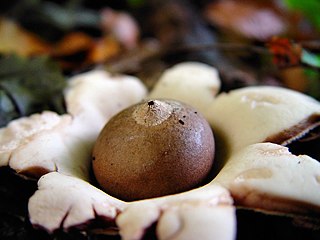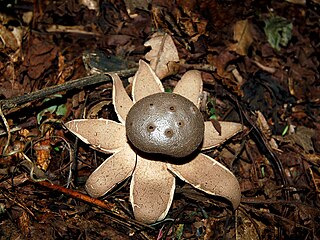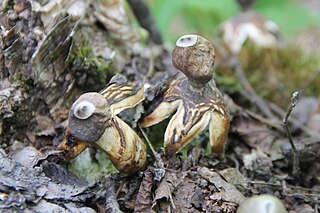
Puffballs are a type of fungus featuring a ball-shaped fruit body that bursts on contact or impact, releasing a cloud of dust-like spores into the surrounding area. Puffballs belong to the division Basidiomycota and encompass several genera, including Calvatia, Calbovista and Lycoperdon. The puffballs were previously treated as a taxonomic group called the Gasteromycetes or Gasteromycetidae, but they are now known to be a polyphyletic assemblage.

Geastrales is an order of gasterocarpic basidiomycetes (fungi) that are related to Cantharellales. The order contains the single family Geastraceae, which includes the "earthstars" formerly placed in Lycoperdales, or Phallales.

Geastrum is a genus of puffball-like mushrooms in the family Geastraceae. Many species are commonly known as earthstars.

Geastrum fornicatum, commonly known as the acrobatic earthstar or the arched earthstar, is an inedible species of mushroom in the family Geastraceae. Like other earthstar mushrooms, the thick outer skin splits open at maturity, exposing the spore sac to the elements. It is found in the southwest United States.

Myriostoma is a fungal genus in the family Geastraceae. Basidiocarps resemble earthstars, but the spore sac is supported by multiple columns and has multiple ostioles instead of a single, apical ostiole. Until 2017, the genus was thought to be monotypic with a single, widespread species, Myriostoma coliforme. Recent research has, however, shown that at least six species occur worldwide.

Geastrum saccatum, commonly known as the sessile earthstar or rounded earthstar, or star of the land, is a species of mushroom belonging to the genus Geastrum. The opening of the outer layer of the fruiting body in the characteristic star shape is thought to be due to a buildup of calcium oxalate crystals immediately prior to dehiscence. G. saccatum is distinguished from other earthstars by the distinct circular ridge or depression surrounding the central pore.
Geastrum berkeleyi, or Berkeley's earthstar, is an inedible species of mushroom belonging to the genus Geastrum, or earthstar fungi. It can be distinguished from other Geastrum species by the flat bipyramidal shape of the calcium oxalate crystals found on its endoperidium.

Geastrum fimbriatum, commonly known as the fringed earthstar or the sessile earthstar, is an inedible species of mushroom belonging to the genus Geastrum, or earthstar fungi.

Geastrum pectinatum is an inedible species of mushroom belonging to the earthstar family of fungi. Although young specimens are spherical, fruit body development involves the outer layer of tissue splitting open like a star into 7 to 10 pointed rays that eventually bend back to point downward, revealing a small – 1 to 2.5 cm broad – spore sac. The spore sac is supported by a small radially wrinkled stalk. There is a distinct conical opening (peristome) at the top of the spore sac that is up to 8 mm long. It is commonly known as the beaked earthstar or the beret earthstar, in reference to the shape of the spore sac and its prominent, protruding peristome. The mass of spores and surrounding cells within the sac, the gleba, is dark-brown, and becomes powdery in mature specimens. Spores are spherical, measuring 4 to 6 micrometers in diameter, with warts on their surfaces.

Astraeus hygrometricus, commonly known as the hygroscopic earthstar, the barometer earthstar, or the false earthstar, is a species of fungus in the family Diplocystaceae. Young specimens resemble a puffball when unopened. In maturity, the mushroom displays the characteristic earthstar shape that is a result of the outer layer of fruit body tissue splitting open in a star-like manner. The false earthstar is an ectomycorrhizal species that grows in association with various trees, especially in sandy soils. A. hygrometricus was previously thought to have a cosmopolitan distribution, though it is now thought to be restricted to Southern Europe, and Astraeus are common in temperate and tropical regions. Its common names refer to the fact that it is hygroscopic (water-absorbing) and can open up its rays to expose the spore sac in response to increased humidity, then close them up again in drier conditions. The rays have an irregularly cracked surface, while the spore case is pale brown and smooth with an irregular slit or tear at the top. The gleba is white initially, but turns brown and powdery when the spores mature. The spores are reddish-brown and roughly spherical with minute warts, measuring 7.5–11 micrometers in diameter.

Astraeus is a genus of fungi in the family Diplocystaceae. The genus, which has a cosmopolitan distribution, contains nine species of earthstar mushroom. They are distinguished by the outer layer of flesh (exoperidium) that at maturity splits open in a star-shape manner to reveal a round spore sac. Additionally, they have a strongly hygroscopic character—the rays will open when moist, but when hot and dry will close to protect the spore sac. Species of Astraeus grow on the ground in ectomycorrhizal associations with trees and shrubs. Despite their similar appearance to the Geastrum earthstars Astraeus is not closely related.

Geastrum triplex is a fungus found in the detritus and leaf litter of hardwood forests around the world. It is commonly known as the collared earthstar, the saucered earthstar, or the triple earthstar—and less commonly by the alternative species name Geastrum indicum. It is the largest member of the genus Geastrum and expanded mature specimens can reach a tip-to-tip length of up to 12 centimeters.

Geastrum quadrifidum, commonly known as the rayed earthstar or four-footed earthstar, is an inedible species of mushroom belonging to the genus Geastrum, or earthstar fungi. First described scientifically by Christian Hendrik Persoon in 1794, G. quadrifidum is a cosmopolitan—but not common—species of Europe, the Americas, Africa, Asia, and Australasia. The fungus is a saprobe, feeding off decomposing organic matter present in the soil and litter of coniferous forests.

Geastrum welwitschii is a species of fungus in the earthstar family. First collected from Spain in the mid-19th century, the fungus is distributed in Europe, North America, and Bermuda.
Patricio Ponce de León was a Cuban mycologist. He was a professor at Belen School in Havana and at the University of Havana, and later a curator at the Field Museum of Natural History in Chicago, Illinois. He wrote a monograph on the worldwide species of the family Geastraceae, the earthstar fungi. Ponce de León died in Miami, Florida.

Myriostoma coliforme, commonly known as the saltshaker earthstar or pepper pot, is a fungal species in the family Geastraceae. Basidiocarps resemble earthstars, but the spore sac is supported by multiple columns and has multiple ostioles instead of a single, apical ostiole. It has also been called "salt-shaker earthstar". The fungus has a north temperate distribution, but was formerly thought to be more widespread due to confusion with related Myriostoma species. Myriostoma coliforme is an uncommon species and appears on the Red Lists of 12 European countries. In 2004 it was one of 33 species proposed for protection under the Bern Convention by the European Council for Conservation of Fungi.

Geastrum minimum, the tiny earthstar, is an inedible species of mushroom belonging to the genus Geastrum. Although rare, it is widespread in Europe, where it occurs in a range of habitats. It is a priority species in the UK, where it has been found in the sand dunes at Holkham National Nature Reserve.
Geastrum britannicum is a fungal species in the family Geastraceae. Its recommended English name is vaulted earthstar. Like other earthstars, the basidiocarps are initially globose. Their thick outer skin splits open at maturity to expose the puffball-like spore sac surrounded by the split rays of the outer skin. In the vaulted earthstar, the rays split apart and form an arch, raising the spore sac upwards.
Geastrum aculeatum is a species of mushroom belonging to the genus Geastrum, or earthstar fungi. It is found in eastern Brazil.
Geastrum huneckii is a species of earthstar fungus in the family Geastraceae. Found in Mongolia, it was formally described as a new species in 1981 by German mycologist Heinrich Dörfelt. The species epithet honours his colleague Siegfried Huneck. Characteristics of the fungus include its hygroscopic exoperidium with four rays, a white endoperidium with a well-delimited peristome, and basidiospores measuring 5.5–6.5 μm in diameter.














